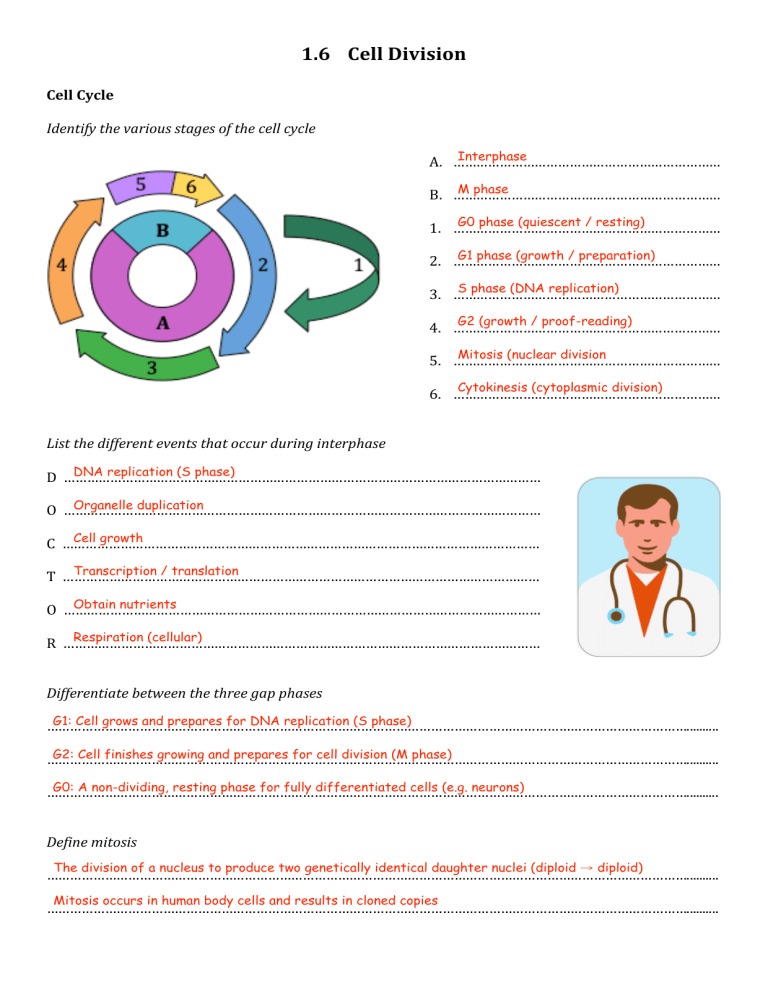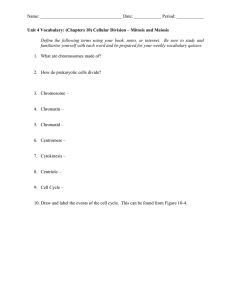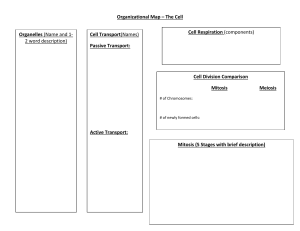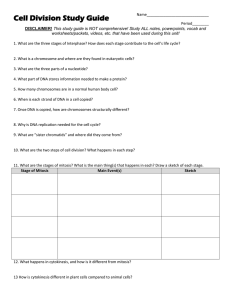
1.6 Cell Division Cell Cycle Identify the various stages of the cell cycle Interphase A. …………………………………………………………… M phase B. …………………………………………………………… G0 phase (quiescent / resting) 1. …………………………………………………………… G1 phase (growth / preparation) 2. …………………………………………………………… S phase (DNA replication) 3. …………………………………………………………… G2 (growth / proof-reading) 4. …………………………………………………………… Mitosis (nuclear division 5. …………………………………………………………… Cytokinesis (cytoplasmic division) 6. …………………………………………………………… List the different events that occur during interphase DNA replication (S phase) D …………………………………………………………………………………………………………… Organelle duplication O …………………………………………………………………………………………………………… Cell growth C …………………………………………………………………………………………………………… Transcription / translation T …………………………………………………………………………………………………………… Obtain nutrients O …………………………………………………………………………………………………………… Respiration (cellular) R …………………………………………………………………………………………………………… Differentiate between the three gap phases G1: Cell grows and prepares for DNA replication (S phase) ………………………………………………………………………………………………………………………………………………….......... G2: Cell finishes growing and prepares for cell division (M phase) ………………………………………………………………………………………………………………………………………………….......... G0: A non-dividing, resting phase for fully differentiated cells (e.g. neurons) ………………………………………………………………………………………………………………………………………………….......... Define mitosis The division of a nucleus to produce two genetically identical daughter nuclei (diploid → diploid) ………………………………………………………………………………………………………………………………………………….......... Mitosis occurs in human body cells and results in cloned copies ………………………………………………………………………………………………………………………………………………….......... Outline, with a diagram, the changes in DNA organisation during interphase and mitosis DNA is usually loosely packed within the nucleus as chromatin ………………………………………………………………………………………... During mitosis, the DNA supercoils and chromatin condenses ………………………………………………………………………………………... to form visible chromosomes ………………………………………………………………………………………... Because DNA is replicated in the S phase, each chromosome ………………………………………………………………………………………... is made of identical sister chromatids ………………………………………………………………………………………... Describe the stages of mitosis Stage Diagram Description • Chromosomes condense (DNA supercoils) • Nuclear membrane dissolves Prophase • Paired centrosomes move to opposite poles of the cell and start producing spindle fibres • Spindle fibres connect to centromeres of chromosomes Metaphase • Contraction of spindle fibres cause chromosomes to align along the middle of the cell (equatorial plane) • Spindle fibres continue to contract and this results in Anaphase the separation of the identical sister chromatids • Each chromatid is now referred to as a chromosome • The identical chromosomes move to opposite poles • Chromosomes decondense Telophase • Nuclear membranes reform around the two separate sets of identical chromosomes • Cytokinesis occurs concurrently to split the cell in two Compare the process of cytokinesis in animal cells and plant cells Animals: Microtubule filaments form a ring around the cell centre which then contracts (cleavage furrow) ………………………………………………………………………………………………………………………………………………….......... Separation is centripedal because it starts at the outside and then moves in ………………………………………………………………………………………………………………………………………………….......... Plants: Vesicles form in a row at the centre of the cell (equatorial plane) which fuse to form an end plate ………………………………………………………………………………………………………………………………………………….......... Separation is centrifugal because it starts in the centre and then moves out ………………………………………………………………………………………………………………………………………………….......... List four processes that involve mitosis Tissue repair T …………………………………………………………………………………………………………………… Organismal growth O …………………………………………………………………………………………………………………… Asexual reproduction (e.g. vegetative propagation) A …………………………………………………………………………………………………………………… Development of an embryo D …………………………………………………………………………………………………………………… Identify the stages of mitosis and calculate the mitotic index 4, 5, 6, 8, 10, 13, 15, 16, 18 Interphase: ……...…………………………………………… 7, 9 Anaphase: ……….…………………………………………… 2, 14 Prophase: ………..…………………………………………… Telophase: …………………………………………………… 1, 11, 17 Metaphase: …………...……………………………………… 3, 12 9 ÷ 18 = 0.5 Mitotic Index: ………….…………………………………… Cell Cycle Regulation Outline the role of cyclins in the control of the cell cycle Cyclins are a family of regulatory proteins that control progression of the cell cycle ………………………………………………………………………………………………………………………………………………….......... Cyclins bind cyclin dependent kinases (CDKs) and form an activated complex ………………………………………………………………………………………………………………………………………………….......... This complex phosphorylates proteins involved in specific cell cycle events ………………………………………………………………………………………………………………………………………………….......... After the event has occurred, the cyclin is degraded and CDK rendered inactive ………………………………………………………………………………………………………………………………………………….......... Compare apoptosis and necrosis as mechanisms of cell death Apoptosis Necrosis Programmed cell death (i.e. cell ‘suicide’) ………………………………………………………………………… Uncontrolled cell death (i.e. cell ‘homicide’) ………………………………………………………………………… Involves cellular signals and mitochondrial proteins ………………………………………………………………………… Premature death of cell due to injury or trauma ………………………………………………………………………… Membrane bulges (blebs) and contents are then ………………………………………………………………………… Membrane destabilises, leading to cell lysis ………………………………………………………………………… repackaged for recycling by other cells ………………………………………………………………………… Released cell contents trigger inflammation ………………………………………………………………………… Define cancer Cancer is uncontrolled cell proliferation ………………………………………………………………………………………………………………………………………………….......... Distinguish between primary and secondary tumours Tumours are the growths caused by cancer and may be benign (stays local) or malignant (spreads) ………………………………………………………………………………………………………………………………………………….......... A benign tumour that remains in its original location is called a primary tumour ………………………………………………………………………………………………………………………………………………….......... A tumour that has spread (metastasised) is called a secondary tumour ………………………………………………………………………………………………………………………………………………….......... Outline the role of mutagens and oncogenes in the development of cancer A mutagen is an agent that causes a change in the genetic material of an organism ………………………………………………………………………………………………………………………………………………….......... • E.g. Chemicals in cigarettes may cause cancer (carcinogens) ………………………………………………………………………………………………………………………………………………….......... An oncogene is a gene that has the potential to cause cancer ………………………………………………………………………………………………………………………………………………….......... • Proto-oncogenes code for proteins that promote cell growth and proliferation ………………………………………………………………………………………………………………………………………………….......... • Tumor suppressor genes code for proteins that repress cell cycle progression …………………………………………………………………………………………………………………………………………………..........








